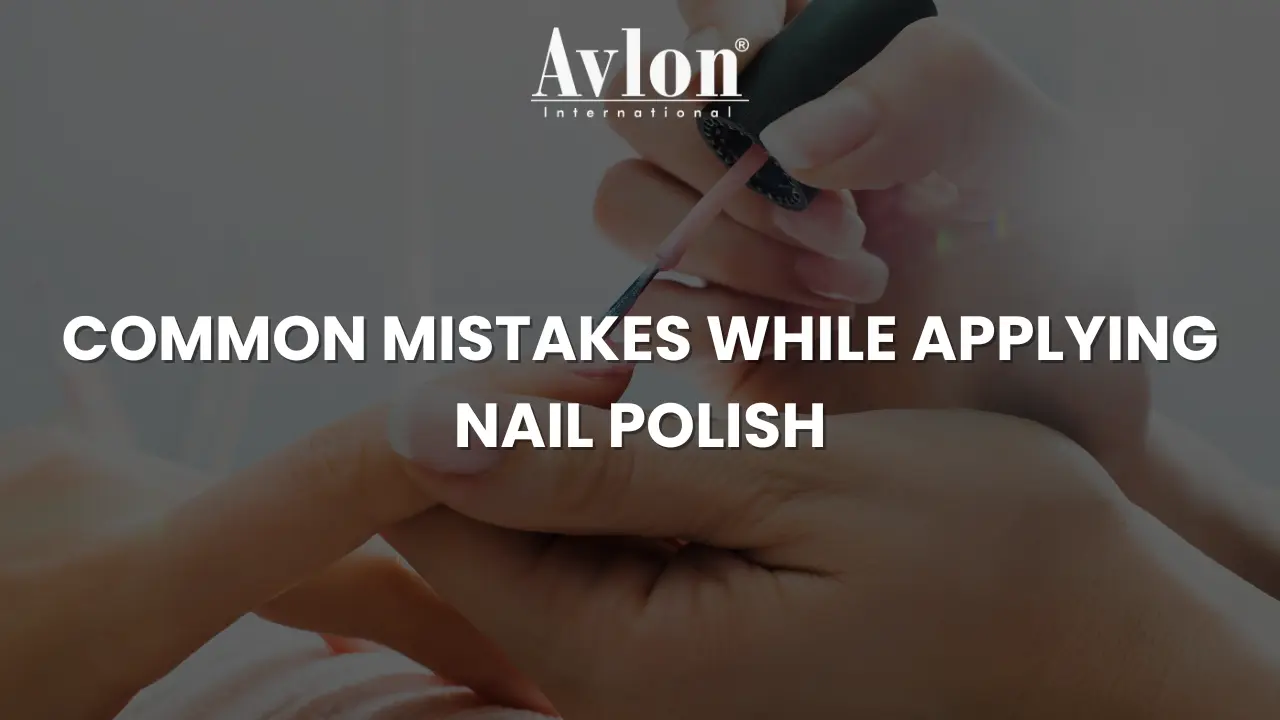Common Mistakes While Applying Nail Polish and How to Avoid Them

For Distributors & Wholesalers
We welcome partnerships with distributors and wholesalers who wish to expand their business with a trusted and growing cosmetic brand.
Why Partner with Avlon International?
- Wide range of cosmetics: Nail polish, mascara, kajal, eyeliner, liquid lipstick, lipstick & more.
- Premium quality with competitive wholesale pricing.
- Attractive margins and fast-moving products.
- Assured support with marketing materials & promotional offers.
- PAN India shipping with secure packaging.
📦 Minimum Order Quantity (MOQ): 1 master carton (72 trays)
💰 Special Discounts: Available for bulk & long-term partners.
🚚 Dispatch & Delivery: PAN India in around 10-15 days.
📞 Contact Us:
Phone / WhatsApp: +91 88105 67775
Email: contactus@avloninternational.com
Website: www.avloninternational.com
Let’s face it – we’ve all been there. You’re sitting at your vanity, armed with your favorite bottle of nail polish, feeling like you’re about to create a masterpiece. Fast forward twenty minutes, and your nails look like they’ve been through a tornado. Sound familiar? Don’t worry, you’re not alone in this colorful catastrophe!
Nail polish application might seem straightforward, but it’s actually an art form that requires patience, practice, and the right techniques. Whether you’re a beginner who’s just discovered the joy of painted nails or someone who’s been struggling with the same mistakes for years, this comprehensive guide will transform your at-home manicure game forever.
The Foundation Fiasco: Skipping Nail Preparation
One of the biggest mistakes people make is jumping straight into polish application without proper nail preparation. Think of your nails as a canvas – would an artist start painting on a dirty, uneven surface? Absolutely not!
The Problem: Applying polish to unprepared nails results in uneven application, poor adhesion, and significantly shorter wear time. Your beautiful manicure might chip within hours instead of lasting for days.
The Solution: Start with clean, dry nails. Remove any old polish completely, push back your cuticles gently, and file your nails into your desired shape. Use a gentle nail buffer to smooth out any ridges, but don’t over-buff as this can weaken your nails. Finally, wipe each nail with rubbing alcohol or nail dehydrator to remove any oils that might prevent proper polish adhesion.
When selecting quality products for your nail preparation routine, Avlon International offers excellent options that professional nail technicians trust. Their preparation products ensure your nails are perfectly primed for polish application.
Base Coat Blunders: The Invisible Foundation
Here’s a mistake that makes nail enthusiasts everywhere cringe: skipping the base coat. We get it – you’re excited to see that gorgeous color on your nails, and base coat seems like an unnecessary extra step. But trust us, this “invisible” layer is absolutely crucial!
The Problem: Without a base coat, your nail polish won’t adhere properly, leading to chips, peeling, and uneven coverage. Additionally, dark or highly pigmented polishes can stain your natural nails yellow or leave them discolored.
The Solution: Always, and we mean always, apply a thin layer of base coat before your colored polish. This creates a smooth surface for even application and acts as a protective barrier for your natural nails. Let it dry completely before moving on to your color – patience is key here!
A quality base coat should go on smoothly and create an ideal foundation for your manicure. Look for formulas that strengthen nails while providing excellent adhesion for your polish.
The Thick Layer Trap: More Isn’t Always Better
We’ve all made this mistake – thinking that one thick coat will save time and give us that rich, opaque color we’re after. Unfortunately, this approach usually backfires spectacularly.
The Problem: Thick coats take forever to dry, are more likely to bubble, smudge, or develop an uneven texture, and actually chip more easily than multiple thin coats. You might end up with a goopy, streaky mess that never seems to fully cure.
The Solution: Apply multiple thin coats instead of one or two thick ones. Start with a thin first coat – it might look streaky or sheer, but don’t panic! This first layer is just the foundation. Apply a second thin coat, and if needed, a third. Each thin layer should be allowed to dry completely before applying the next.
This technique requires patience, but the results are worth it. You’ll achieve better color saturation, smoother finish, and longer-lasting wear. Professional nail technicians swear by this method, and many prefer working with high-quality polish lines like those from Avlon International for their superior formula consistency.
Cuticle Catastrophes: Painting Outside the Lines
Nothing screams “amateur manicure” quite like polish all over your cuticles and skin. This common mistake can make even the most expensive polish look sloppy and unprofessional.
The Problem: Getting polish on your cuticles and surrounding skin creates a messy appearance and can actually make your manicure chip faster as the polish on your skin peels away.
The Solution: Take your time and use proper brush technique. Load your brush with just enough polish – not too much, not too little. Start with the brush slightly away from your cuticle and gently push the polish toward the base of your nail, leaving a tiny gap between the polish and your cuticle. This technique takes practice, but it’s game-changing once you master it.
If you do make mistakes (and we all do!), don’t try to fix them while the polish is wet. Instead, let everything dry completely, then use a small brush dipped in nail polish remover to clean up any errors. Cotton swabs work too, but a small, flat brush gives you more precision.
The Drying Dilemma: Rushing the Process
In our fast-paced world, waiting for nail polish to dry feels like torture. But rushing this crucial step is a recipe for disaster that leads to smudges, dents, and completely ruined manicures.
The Problem: Wet polish is incredibly vulnerable. Even the slightest touch can leave permanent marks, and what looks dry on the surface might still be wet underneath, leading to sheet marks or dents hours later.
The Solution: Plan ahead and give yourself plenty of time. Each coat needs adequate drying time – usually 2-3 minutes between coats and at least 15-20 minutes after your final coat before engaging in any activities. Consider investing in a nail drying spray or quick-dry top coat to speed up the process safely.
Test if your nails are truly dry by gently tapping them together. If they make a clicking sound, you’re good to go. If they feel tacky or stick together slightly, give them more time.
Top Coat Troubles: Skipping the Protective Shield
Just as base coat is essential for adhesion, top coat is crucial for protection and longevity. Yet many people skip this final step, either from impatience or thinking it’s optional.
The Problem: Without top coat, your manicure lacks protection from daily wear and tear. The color will chip more easily, lose its shine quickly, and overall wear time will be significantly reduced.
The Solution: Always finish with a quality top coat. This final layer seals your color, adds shine, and provides a protective barrier against chips and scratches. Apply it over the entire nail, including the tip, for maximum protection.
Reapply top coat every few days to maintain shine and extend your manicure’s life. This simple step can make your nail polish last up to a week longer!
Brush Technique Blunders: It’s All in the Wrist
The way you hold and use the polish brush makes a huge difference in your final results. Many people develop bad habits that lead to streaky, uneven application.
The Problem: Using too much pressure, applying polish in multiple directions, or not utilizing the full width of the brush leads to streaky, uneven coverage that looks unprofessional.
The Solution: Use light pressure and let the brush do the work. The ideal technique involves three strokes per nail: one down the center and one on each side. Keep your strokes smooth and consistent, and try to complete each nail without going back over areas you’ve already painted.
Practice makes perfect with brush technique. Start with your non-dominant hand (it’s usually easier) and work your way up to your dominant hand as your skills improve.
Color Choice Chaos: Wrong Shades for Your Skin Tone
Choosing the wrong color for your skin tone can make even perfectly applied polish look off. This mistake is more about understanding what works for you rather than following trends blindly.
The Problem: Colors that clash with your skin tone can make your hands look washed out, aged, or simply unflattering, regardless of how well the polish is applied.
The Solution: Learn what colors complement your skin tone. Cool undertones typically look great in blues, purples, and true reds, while warm undertones shine in corals, oranges, and warm reds. When in doubt, classic nudes and soft pinks are universally flattering options.
Don’t be afraid to experiment, but pay attention to how different colors make your hands look. The right shade should enhance your natural beauty, not compete with it.
Storage and Maintenance Mistakes: Keeping Your Polish Fresh
How you store and maintain your nail polish affects its performance and longevity. Many people unknowingly sabotage their polish before they even start painting.
The Problem: Improper storage leads to thickened, gooky polish that’s difficult to apply evenly. Extreme temperatures, exposure to light, and poor cap sealing all contribute to polish degradation.
The Solution: Store your polishes in a cool, dark place away from direct sunlight and temperature fluctuations. Always clean the neck of the bottle before replacing the cap to ensure a tight seal. If your polish becomes thick, add a few drops of nail polish thinner (never acetone!) to restore its consistency.
Quality polish lines like Avlon International typically have longer shelf lives and better formulations that resist separation and thickening, making them excellent investments for your collection.
The Cleanup Catastrophe: Fixing Mistakes the Wrong Way
Everyone makes mistakes during application, but how you fix them can make or break your manicure. Many people use techniques that actually make things worse.
The Problem: Trying to fix wet mistakes often spreads the problem, while using harsh cleanup methods can damage surrounding polish or skin.
The Solution: For wet mistakes, resist the urge to immediately fix them. Let everything dry completely first, then use precise cleanup tools. A small brush dipped in remover works better than cotton balls or swabs for detailed work.
For major mistakes, it’s often better to remove the polish from that nail entirely and start over rather than trying to patch it up.
Planning and Timing Troubles: Setting Yourself Up for Success
Poor planning is behind many nail polish disasters. Rushing through the process or choosing the wrong time for your manicure often leads to frustration and subpar results.
The Problem: Doing your nails when you’re rushed, tired, or likely to be interrupted increases the chance of mistakes and doesn’t allow proper drying time.
The Solution: Choose a time when you can focus completely on your manicure without interruptions. Gather all your supplies beforehand, ensure good lighting, and create a comfortable workspace. Consider doing your nails in the evening when you won’t need to use your hands much afterward.
The Environmental Factor: Creating the Perfect Manicure Space
Your environment plays a bigger role in nail polish success than you might think. Factors like humidity, temperature, and lighting all affect your results.
The Problem: High humidity can prevent proper drying, poor lighting makes it difficult to see what you’re doing, and uncomfortable positioning leads to shaky application.
The Solution: Create an ideal manicure space with good lighting, comfortable seating, and stable surfaces. If possible, do your nails in a room with moderate humidity and stable temperature. Use a desk lamp or natural light to see your work clearly.
Professional Tips for Home Success
Learning from professional nail technicians can elevate your at-home manicure game. Here are some insider secrets:
- Always cap the free edge (paint over the tip) to prevent chipping
- Use a fan or nail dryer to speed drying safely
- Apply thin coats in opposite directions for each layer to prevent streaking
- Keep a cleanup brush ready for immediate touch-ups
- Practice regularly to build muscle memory and confidence
Many professionals recommend working with salon-quality products like those from Avlon International, which offer superior formulations that are easier to work with and provide better results than typical drugstore options.
Conclusion: Your Path to Polish Perfection
Mastering nail polish application is a journey, not a destination. Everyone makes mistakes – even professional nail technicians had to start somewhere! The key is learning from these common pitfalls and developing good habits that will serve you well throughout your nail art journey.
Remember, the most important ingredients for a successful manicure are patience, practice, and quality products. Don’t get discouraged if your first attempts aren’t perfect. With time and consistent effort, you’ll develop the skills and techniques needed to create salon-worthy manicures in the comfort of your own home.
Whether you’re preparing for a special event or simply want to treat yourself to beautiful nails, avoiding these common mistakes will help you achieve the flawless, long-lasting results you’ve always wanted. Your nails are an extension of your personal style – make sure they’re representing you at their very best!
With the right approach, quality products from trusted brands like Avlon International, and plenty of practice, you’ll soon be creating manicures that rival those from professional salons. So grab your favorite polish, set aside some quality time, and get ready to fall in love with your perfectly polished nails!
📌 Disclaimer
The information provided in this blog is for general informational purposes only. While Avlon International makes every effort to ensure the accuracy and reliability of the information shared, we make no representations or warranties of any kind, express or implied, about the completeness, accuracy, reliability, suitability, or availability with respect to the content.
Any reliance you place on such information is therefore strictly at your own risk. Avlon International shall not be held liable for any loss, damage, or inconvenience arising in connection with the use of this blog or its content.
For official details regarding our products, distributor policies, or business partnerships, please contact us directly at WhatsApp +91 88105 67775.




